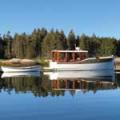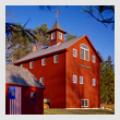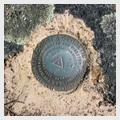Husking Corn, Farmington, Maine
 Courtesy Penobscot Marine Museum
Courtesy Penobscot Marine Museum
Workers are husking sweet corn at one of several area canning factories or corn shops. While Oxford County was the heart of Maine’s sweet corn belt, the Farmington area, featuring deep intervale soils along the Sandy River and warm inland nights, was a heavy player in the industry. After about 1930 the northern New England corn-canning industry—it had spread from Maine to New Hampshire and Vermont—began a slow decline. The last corn canned in Maine was from a Farmington factory in 1968.
Local women and also children supplied important labor for corn factories. The month-or-so canning season, in September, was a social occasion as well as an economic opportunity for workers, especially for shuckers. A good shucker might fill 25 to 32 bushel baskets in a day, perhaps for 5 cents a basket. Shucking machinery was introduced about 1920. The brown ash baskets were made by Maine’s Indigenous Peoples who traveled from customer to customer, making baskets from local ash trees. Cans were manufactured at the shops during the off season.
✮
This photo is from the Eastern Illustrating & Publishing Collection at the Penobscot Marine Museum. The photo appears in the book Maine on Glass, by W.H. Bunting, Kevin Johnson, and Earle G. Shettleworth Jr., and published by the museum. It was also included in the museum’s exhibit “Maine Agriculture: Views from the Past.”
Related Articles
Share this article:
2023 Maine Boat & Home Show

Join Us for the Maine Boat & Home Show!
Art, Artisans, Food, Fun & Boats, Boats, Boats
August 11 - 13, 2023 | On the waterfront, Rockland, Maine
Click here to pre-order your tickets.
Show is produced by Maine Boats, Homes & Harbors magazine.















